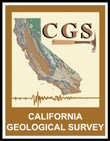
|
California Division of Mines and Geology
Bulletin 202 Geology of the Point Reyes Peninsula, Marin County, California |
ABSTRACT
The Point Reyes Peninsula is a triangle of land about 100 square miles in area in western Marin County, California, bounded on the east by the valley of the San Andreas fault zone and on the remaining sides by the Pacific Ocean. This report describes the geology of the land west of the San Andreas fault zone on this peninsula. The principal topographic features are the linear depressions of the Olema Valley, Bolinas Lagoon, Tomales Boy, the high land of Inverness Ridge immediately west of these depressions, and the promontory of Point Reyes.
The oldest rocks of the area are the metamorphosed limestones and schists which occur as roof pendants in the granitic rocks of Inverness Ridge. Overlying the granitic rocks at Point Reyes is the Paleocene Point Reyes Conglomerate. At Inverness Ridge the granitic rocks are overlain by Miocene Monterey Shale of Relizian to Mohnian age. The Pliocene Drakes Bay Formation lies between Point Reyes and Inverness Ridge. These beds lie unconformably on the Monterey Shale and overlap onto the granitic basement at Point Reyes. The Pliocene Merced Formation, close to Bolinas, is very similar to that of the type section of the Merced Formation 20 miles to the southeast. These beds lie on rocks of the Franciscan Formation which are involved in the fault zone. The Pleistocene (?) Olema Creek Formation lies on rocks of the Franciscan Formation in the fault zone near Olema. Pleistocene non-marine terrace deposits overlie wove-cut platforms of Miocene rocks in several places. Old beach deposits of Pleistocene age are found at McClure's Beach on the west side of Tomales Point and along Point Reyes Beach. A very large area of ancient landsliding is found near Double Point.
Pleistocene non-marine terrace deposits overlie wave-cut platforms of Miocene rocks in several places. Old beach deposits of Pleistocene age are found at McClure's Beach on the west side of Tomales Point and along Point Reyes Beach. A very large area of ancient landsliding is found near Double Point.
The structure of the area is dominated by the San Andreas fault zone which is about a mile and a half wide and traverses the Franciscan, Miocene, and granitic rocks. The surface rupture of the 1906 San Francisco earthquake lies toward the center of the fault zone at the south end of the Olema Valley, but lies closer to the west side of the fault zone at the north end. There is abundant topographic evidence of numerous earlier fault—traces within the fault zone. The zone here occupies a line of uplift, the blocks on each side tilting away from the fault zone. Indirect evidence suggests that the amount of lateral movement on the San Andreas fault has been on the order of 100 miles or more.
There are no active commercial operations for the extraction of minerals in the area at the present time. Oil and gas showings are abundant in Miocene and the Pliocene sediments, and a few exploratory wells have been drilled to test the prospects of the area. No commercial production has been found; the area has not been thoroughly explored for petroleum, but the prospects for any large accumulations of petroleum underlying the land area are not good.
| <<< Previous | <<< Contents >>> | Next >>> |
state/ca/cdmg-bul-202/abstract.htm
Last Updated: 28-Nov-2007